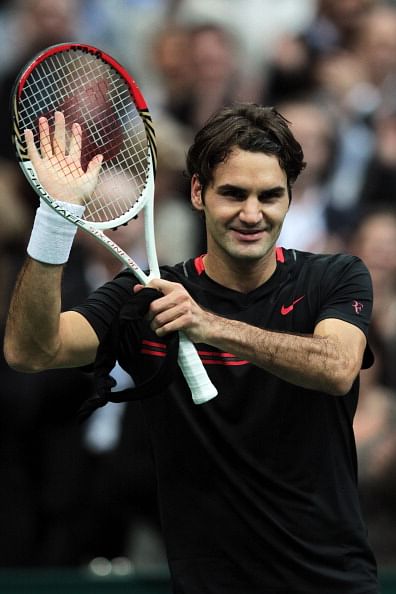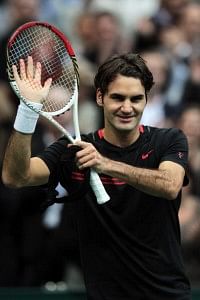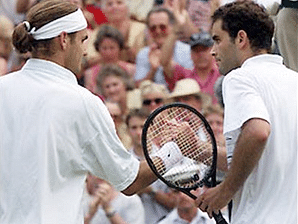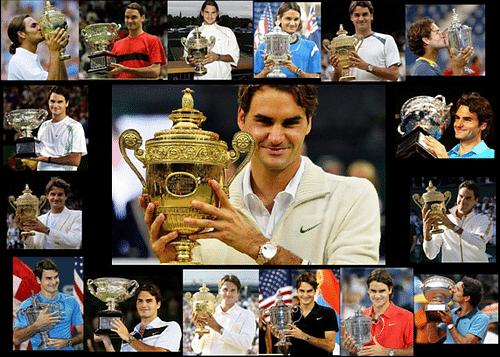
The greatest tennis players of all time - No. 2
Continuing with our series on the greatest tennis players of all time, here’s No. 2 on our list.
No. 2 – Roger Federer
 The history of every sport has this one type of athlete. These athletes enter the folds of the game like every other person, one amidst the crowd. But over the years, they rise above them all. Then just when it looks like this is as far as they would get, they push the envelope further and define new heights. They shatter records, set new standards, attain hallowed status, delight their fans and mesmerise their opponents. And eventually, when they do leave their sport, they become synonymous with excellence, with the word ‘champion’ and more importantly, with the very game they chose to play. Think of Michael Jordan and basketball, Sergei Bubka with pole-vaulting, Dhyan Chand with hockey and Pele with football.
The history of every sport has this one type of athlete. These athletes enter the folds of the game like every other person, one amidst the crowd. But over the years, they rise above them all. Then just when it looks like this is as far as they would get, they push the envelope further and define new heights. They shatter records, set new standards, attain hallowed status, delight their fans and mesmerise their opponents. And eventually, when they do leave their sport, they become synonymous with excellence, with the word ‘champion’ and more importantly, with the very game they chose to play. Think of Michael Jordan and basketball, Sergei Bubka with pole-vaulting, Dhyan Chand with hockey and Pele with football.
To just witness these players in action is an experience in itself. And there is one such player who has weaved his own bit of magic over the past few years. Every time he walks on to the court, with each step he takes, with every twang of the strings on his racquet and each breath he takes, he is making history. He is excellence, he is the champion and he is synonymous with tennis. He is Roger Federer.
Like all prodigies, Federer displayed quite a flair for sports from a very young age. Growing up in Switzerland, he dabbled in cricket, badminton, football and table tennis. However, in 1985, when Boris Becker won his first Wimbledon title, he got young Roger hooked on to tennis. For hours on end Federer would hit against the garage wall with his racquet, without tiring. After starting school, he became the best of the lot and was soon attending separate practice sessions. He was a quick learner. He was separated from group lessons after his talent became obvious. Even back then, he wanted to be the best in the world, and his determination was clearly visible.
This was the time he ran into a man who would go on to have a tremendous influence on his life – Peter Carter. Carter was highly impressed by Federer. “Oh, have I got a young boy here who looks promising. He’s only about 12 or 13. I think he’s going to go places”, he once said of Roger. Through tennis and travel, Carter and Federer would become very close to each other on a personal level.
Federer’s rise was predictable. He was often too good for his age group and even those above. He was only 14 when he became the national champion of Switzerland across all age groups. He joined the ITF juniors’ circuit in 1996 and at the age of 17, he was the Wimbledon boys’ champion and the World No. 1 junior.
But there was a period when it didn’t look like he was going to waltz his way into the pages of history. We have become so used to his calm and composed performances that little do we realise there is an avalanche of emotions buried under that poker-face. Marco Chiudinelli, who is Federer’s friend and was also once his training partner, narrates this incident from their youth:
“Back then we only played one long set of up to nine games. Things weren’t going well for me at the beginning. I was behind 2–5 and I started to cry. We cried a lot back then even during the matches. Roger came up to me and tried to comfort me when we switched sides. He told me everything would be alright, and in fact, things got better. I took the lead, 7–6, and noticed that the tide had turned. Then he began to cry and I ran up to him and give him encouragement and things went better for him. It was the only time I could beat him.”
 He would get frustrated, break racquets, stomp on the court, kick the balls and ostracize himself for every poor shot. He turned pro in 1998 and for three years, he didn’t win a title. He would take his losses very hard. He reached a few finals but was performing nowhere as good as some of his fellow juniors like Lleyton Hewitt, David Nalbandian or Andy Roddick. He himself started wondering if he was going to be one of the guys everyone talked about but who never amounted to anything. Federer’s only claim to fame thus far was a victory over Pete Sampras at Wimbledon in 2001 – for many a ceremonial passing of the baton. But the true passing had not yet happened. His tempestuousness always got the better of him.
He would get frustrated, break racquets, stomp on the court, kick the balls and ostracize himself for every poor shot. He turned pro in 1998 and for three years, he didn’t win a title. He would take his losses very hard. He reached a few finals but was performing nowhere as good as some of his fellow juniors like Lleyton Hewitt, David Nalbandian or Andy Roddick. He himself started wondering if he was going to be one of the guys everyone talked about but who never amounted to anything. Federer’s only claim to fame thus far was a victory over Pete Sampras at Wimbledon in 2001 – for many a ceremonial passing of the baton. But the true passing had not yet happened. His tempestuousness always got the better of him.
Federer tried bottling his emotions and curbing his anger. But while the antics did stop, his shots became almost ordinary and his game almost lifeless. He continued to work on his emotions. Eventually he managed to find the right attitude, balancing fire with composure. And almost immediately, the results followed. In 2002, he won his first big title in Hamburg. However, he was upset at Wimbledon, in the first round itself. Having gone from a quarterfinal appearance in the previous year to a first round loss, Federer was inconsolable. The game was there to take him places, yet he wasn’t going anywhere. Then a tragedy would occur which would go on to change the course of Federer’s career for good.
In late 2002, his friend and former coach Peter Carter died in a car accident. Federer, who was playing in Toronto at that time, was shocked. The loss of a friend and mentor affected him deeply and he took the tragedy incredibly hard. He skipped a tournament to attend the funeral. It was in that moment that Federer made a vow; this was the point that turned him into the lean and efficient machine that he is today. That moment marked the end of Federer’s struggle with his internal demons and made him ready to battle on the court. No more distractions, no more tantrums, and his mind was firmly fixed on tennis. That was the moment when the baton that Sampras had handed over, was truly in Federer’s grip.
Back again a year later in the All-England Club, he was seeded fourth. His friend and first seed, Hewitt, who was the defending champion, had become the only man in the Open era to lose in the first round. But Federer was not disturbed. His progress was smooth and efficient. A week later, he was in new territory: he was in the semi-finals. His opponent was Andy Roddick, the No. 5 seed. In the other semi-final were players ranked far below these two. The winner of this match would be the favourite to win the title. Everyone was talking about Roddick. The American had won at the Queen’s Club and had a huge serve. But Federer was unruffled. He played brilliantly, dispatched Roddick in straight sets and was in his first ever Grand Slam final.
Two days later, he lifted his first Grand Slam trophy.

17 Grand Slam titles, 21 Masters titles, 76 career titles, 297 weeks as World No. 1 (and counting), 23 consecutive Grand Slam semi-finals or better, 10 Major finals in a row…so on and so forth (read them all here). These statistics and numbers speak what they have to. But they don’t reveal how the champion was made or the man that lives behind the player. Roger Federer battled himself and his emotions and then worked hard to channel his skills to become a champion. Success, adulation, money and fame have failed to uproot his feet. The way he carries himself on and off the court, in the press-conferences and with the media, has made him immensely likable. He has gathered fans across the globe numbering in the millions, and continues to get more people hooked on to the sport by simply turning up, match after match. When he plays, he doesn’t just make people look. He engages their senses. When he wins, people rejoice. When he loses, which does happen occasionally, even the people watching feel the loss. He is loved by millions and admired by his opponents. He could have been the antagonist of the occasion when he won against Murray in Wimbledon this year and dashed the hopes of an entire nation. But the sight of him in tears, the sight of his family and his twin daughters in the stadium, would make only the most heartless man call him anything but the hero.
One can only hope it’s nowhere near but one day, it will be time when he hangs his racquet. And when that day does come, we can all say that we were alive when the face of tennis was weaving its magic, creating history, Grand Slam after Grand Slam, day after day, shot after shot.
And now, here’s a look at Federer’s Slam triumphs – all 17 of them – that have decorated his glittering career.
These are the other players who have made it to the list so far:
No. 20 – Venus Williams; No. 19 – Justine Henin; No. 18 – Ken Rosewall; No. 17 – Andre Agassi; No. 16 – Pancho Gonzales; No. 15 – Monica Seles; No. 14 – John McEnroe; No. 13 – Ivan Lendl; No. 12 – Jimmy Connors; No. 11 – Margaret Court; No. 10 – Billie Jean King; No. 9 – Rafael Nadal; No. 8 – Serena Williams; No. 7 – Chris Evert; No. 6 – Bjorn Borg; No. 5 – Pete Sampras; No. 4 – Martina Navratilova; No. 3 – Rod Laver
Read the detailed write-ups on all the players in this list here:
The greatest tennis players of all time